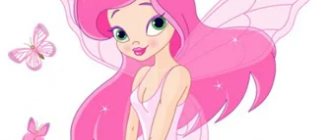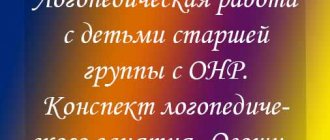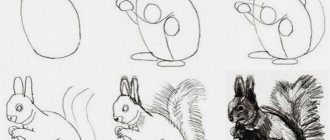Assignments and recipes
Today I propose to complete small and very interesting tasks about the number 7 together with your child.
So what we will need to do:
- Count the colorful gnomes (there will be 7 of them, of course)
- Find the number 7 among many other numbers and circle it.
- Draw 7 different colored pencils onto the pencil case.
- Find all the numbers seven hidden in the hearts.
- Circle the big number 7 seven times, starting from the arrow.
- Find the wallets with seven coins and write the number 7 in the circle next to the wallets with seven coins.
- Paint 7 dwarfs for Snow White.
Developmental tasks for preschoolers and first graders about the number 7.
Copybooks in Russian
Copybooks in English
So, the sacred number 7 is the hero of many genres of folk art . Read fairy tales with your children, recite poems, solve puzzles, no matter what class they go to. Don’t be confused by the fact that learning numbers is not exactly a creative activity!
A very good addition to the lesson about the number seven is a short cartoon from Owl from the Scientific Hollow about this number.
Visual and video aids
As a visual aid, no matter what grade the child goes to, photos with objects or animals, pictures where you need to count something or someone can be used. You can make a humorous photo of the number 7 using computer programs, combining the number with interesting objects or phenomena. You can invite each of the children to take a photo (or demonstrate existing ones) of those objects that are very similar to the number 7. See with what pleasure the children will accept this idea. The photo can also be used if a teacher who is going to a lesson in an elementary class is preparing a presentation. You can also download photos and presentation on the website.
Presentations
- About Snow White and the 7 Dwarfs
- Number and figure 7
- Proverbs, sayings, sayings and poems about numbers
The presentation is simply necessary for a full-fledged lesson and the development of the children. Most children have a visual memory, and presentation promotes maximum learning. However, it must be built wisely. A presentation is not just a set of slides: they must be structured methodically. This means that you must be able to explain your choice of slides at any time. To ensure that your presentation is successful, we suggest that you use a presentation dedicated to the number 7, which can be easily downloaded from our website.
Video materials
Coloring pages
Lesson summary "Number and figure 7" (4-5 years)
Construct
organizing joint educational activities
according to PM 03. “Organization of classes in basic educational programs of preschool education”
Shiryaeva Anna Andreevna
Group:
average
Kind of activity:
gaming, educational, communicative.
Subject:
Number and figure 7
Educational area:
social and communicative development, cognitive development, speech development.
Shapes:
frontal, individual.
Planned result:
- Children are able to determine the properties of objects and organize objects by size. They are able to compare groups of objects by quantity using methods and the application of recalculation.
- Children have ideas about the formation of the number 7 by adding one to the previous number; The ability to count to seven, compare and equalize the number of groups by adding a missing item;
- Children became familiar with the number 7, are able to recognize the number 7 among other numbers, and find its place in the number series.
Target:
to promote the development of children's cognitive interests, the ability to solve age-appropriate intellectual problems, through joint cognitive and research activities, familiarization with numbers and numbers 7
Educational :
- to cultivate activity and initiative in children in the process of direct educational play activities;
- instill interest in cognitive and research activities;
- cultivate a respectful attitude towards peers, a desire to listen to each other’s answers.
Educational:
- develop logical thinking techniques, speech skills:
- develop associative thinking, speech, and the ability to justify one’s skills
- develop speech skills, attention, spatial concepts.
Educational:
- form an idea of the number and number 7, the ability to count to seven and back, relate the number 7 to quantity;
- consolidate geometric concepts, counting skills, the ability to isolate and compare the properties of objects, compare and equalize groups of objects by quantity in two ways, the ability to see and continue a pattern;
- train mental operations (analysis, comparison), develop memory, attention, speech.
- develop the ability to navigate in space using an elementary plan.
- Strengthen knowledge of the color scheme, the ability to correlate objects by color
Denis
– cultivate a respectful attitude towards peers, a desire to listen to the answers of other children
Educational and methodological kit:
- Childhood: An exemplary educational program for preschool education / T.I. Babaeva, A.G. Gogoberidze, O.V. Solntseva and others. St. Petersburg: PUBLISHING HOUSE “CHILDHOOD-PRESS” LLC, 2014.
- Peterson L.G., Kochemasova E.E. Playing game. Practical mathematics course for preschoolers. Guidelines. M.: Balance, 1998. pp. 34-35.
- Federal state educational standard for preschool education / Ministry of Education and Science of the Russian Federation, order dated October 17, 2013 N 1155.
Principles of the Federal State Educational Institution:
- building educational activities based on the individual characteristics of each child, in which the child himself becomes active in choosing the content of his education, becomes a subject of education;
- assistance and cooperation of children and adults, recognition of the child as a full participant (subject) of educational relations;
- supporting children's initiative in various activities;
- formation of cognitive interests and cognitive actions of the child in various types of activities;
Principles of education:
creating a positive emotional background and atmosphere of emotional uplift, education through interaction.
Principles of training:
the principle of accessibility, awareness, activity, visibility.
Education methods:
creating a situation of success, encouragement, motivation for activity.
Teaching methods:
conversation, instruction, demonstration, demonstration, exercise.
Equipment:
cards with numbers 1-9;
7 circles of different sizes; 7 triangles of different colors, coloring pages with the number 7 1. Motivation stage.
Task :
motivate children to participate in joint activities.
Conversation.
The teacher invites the children to go to the carpet and stand in a circle.
Guys, gnomes have come to visit us. They fight because they can't count, do you think Snow White is happy or sad when the dwarfs fight? So that she doesn’t get upset, let’s teach them to be friends, teach them to count.
Children listen to the teacher, stand in a circle
The children became interested in the upcoming activity.
2. Main part.
2.1.Game "Gnomes"
Tasks:
- consolidate the ability to determine the properties of objects, arrange objects by size;
- update children's counting skills within 6, the ability to compare groups of objects by quantity using recalculation techniques and applications;
- train mental operations (analysis and comparison), develop attention, memory, speech.
- Strengthen knowledge of colors, the ability to correlate objects by color
Conversation, demonstration, exercise,
Encouragement.
The teacher invites the children to sit at the tables, where for each child there are 6 circles of different sizes with faces drawn on them.
- These are gnomes.
— How many guests came?
Where do you think the youngest (eldest) gnome is?
Arrange the gnomes by age from oldest to youngest.
Snow White sewed caps for the gnomes. The teacher places 6 triangles of different colors in front of each child (according to the color of the circle)
— How many caps did Snow White sew?
— Do all the gnomes have enough caps?
- Why do you think it’s enough? (Because 6 and 6 are equal.)
But the gnomes don’t know how to count and are worried whether everyone will get a cap.
- How to check this?
But every gnome loves a cap of his own color. Can you choose a cap of your own color for everyone?
Children put a cap on each gnome
.
Children listen to the teacher, answer questions, arrange the circles from largest to smallest. Children match objects by color
Children are able to determine the properties of objects and organize objects by size. They are able to compare groups of objects by quantity using methods and the application of recalculation.
Fizminutka
Task:
help relieve muscle tension, shift attention
-explanation
-show
The teacher invites the children to the carpet
Guys, gnomes love to move and do exercises. Let's move, you and I too, come on to the carpet.
One - rise, stretch, (Stretched.) Two - bend, straighten, (Bent your backs, hands on the belt.) Three - clap your hands, three claps, (Clap your hands.) Three nods with your head. (Move your head.) At four - arms wider, (Arms to the sides.) Five - wave your arms, (Swing your arms.) Six - sit down again. (Sit down.)
Children perform movements according to the text and as shown by the teacher
The children had a rest and prepared to continue the OD
2.2. Game "Caps"
Tasks:
- consolidate children’s ideas about the formation of the number 7 by adding one to the previous number;
- consolidate the ability to count to seven, compare and equalize the number of groups by adding the missing item;
- introduce the composition of the number 7 from ones
- train mental operations analysis, comparison and generalization, develop speech, logical thinking, initiative, creativity.
Conversation, demonstration, instruction, exercise.
— Oh, guys, look, while we were resting, another gnome came running.
Children take one circle from the middle of the table.
— Find the gnome’s place in the general row.
— How many dwarves are there?
Children count in unison, touching each gnome with their finger: 1,2, 3,4,5,6...
— Were you able to count how many dwarves there are? (No Yes)
- Why couldn’t they? (Because we don’t know how to count anymore.)
- So what do we need to do now? (We need to find out how to count further.)
- Who knows what number follows the number six when counting?
The teacher listens to the children’s versions, creating an atmosphere of goodwill and searching. If there are children who name the number 7, the teacher praises them and then asks all the children to count to seven. Children count the gnomes as a chorus, coordinating the numerals with the nouns: one gnome, two, three, four, five, six, seven.
The teacher summarizes
: When counting, the number 6 is followed by the number 7.
— How did you get the number 7? (There were 6 gnomes, they added one more, it became 7.)
—Are there now equal numbers of gnomes and caps? (No, why? What are more: caps or gnomes?
— How to make the number of gnomes and caps equal? (Add another cap.)
Children speak and then add one triangle.
Do you have any extra caps? Is there anything less, who didn't have enough cap?
There are as many gnomes as there are caps, there are as many caps as there are gnomes.
Let's count gnomes, caps, what's more? Equally 7
- How many gnomes? (7.) How many caps? (7.)
The teacher praises the children and concludes: 7 and 7 are equal.
How many gnomes are in the red cap? (1) how many gnomes are in the blue cap? (1) how many gnomes are in the orange cap? (1) The teacher asks the children about each gnome
Children listen, answer the teacher’s questions, and take an active part in the game.
Children have ideas about the formation of the number 7 by adding one to the previous number;
The ability to count to seven, compare and equalize the number of groups by adding a missing item;
2.3 "Snowflakes for Snow White"
Tasks:
- introduce children to the number 7, develop their ability to recognize the number 7 among other numbers, and find its place in the number series
- develop associative thinking, speech, and the ability to justify one’s skills
-Conversation
-Demonstration
-Explanation
-Exercise
The teacher tells
that the dwarves really love their girlfriend, Snow White. The dwarfs decided to please Snow White and give her snowflakes. The youngest gnome was sent for a walk into the forest and asked to collect so many snowflakes so that each gnome could give Snow White one snowflake.
— How many snowflakes does the little gnome need to collect? (Seven.)
But the little gnome is afraid to forget how many snowflakes he needs to collect.
— What should you do to ensure that the gnome does not forget the required number of snowflakes? (You need to write down the number 7.)
What will help us write down numbers?, and they ask you to choose a card with the number seven.
Each child has cards with numbers from 1 to 9. But not everyone knows how to write the number 7
— Were you able to help the gnomes? (No.)
- Why couldn’t they? (Because we don’t know what the number 7 looks like.)
— I’ll read you a poem about this number, and you will find out:
Here's a seven
poker. She has one leg.
What does the number 7 look like? Remove numbers that are not yet known. Lay out the remaining numbers in a row, find the place for the number.
The number 7 comes after the number 6, why? Because the number 7 is greater than the number 6
Guys, you are so great, you helped the younger gnome remember the number 7, now the younger gnome will definitely not forget to collect 7 snowflakes for Snow White.
-Look, our gnomes have stopped quarreling. Why?
-What new number did we meet?
Children actively participate in the conversation, answer the teacher’s questions, and listen to the opinions of other children.
Children became familiar with the number 7, are able to recognize the number 7 among other numbers, and find its place in the number series.
3. Summing up the OA.
Task:
formation of skills to draw OD conclusions, analyze the process of one’s own educational activities.
Conversation.
There are also 7 of our gnomes, what could there be 7 more? (days of the week, rainbow, seven kids, etc.)
What new did you learn?
What did you like best?
What number did we find out today?
We tried on the gnomes. Will Snow White be happy?
Children listen to the teacher and answer questions.
The children jointly formulated the conclusion of the OD and analyzed the process of their own educational activities.
4.Openness.
Task:
to orient children to independent activity in restricted moments.
Demonstration, instructions.
-Guys, I really enjoyed helping the gnomes with you! You are so great! And finally, so that you remember the number, I suggest you color it whenever you want
Children listen to the teacher, thank them for the snowflakes
Children are focused on independent activity in routine moments.
7







